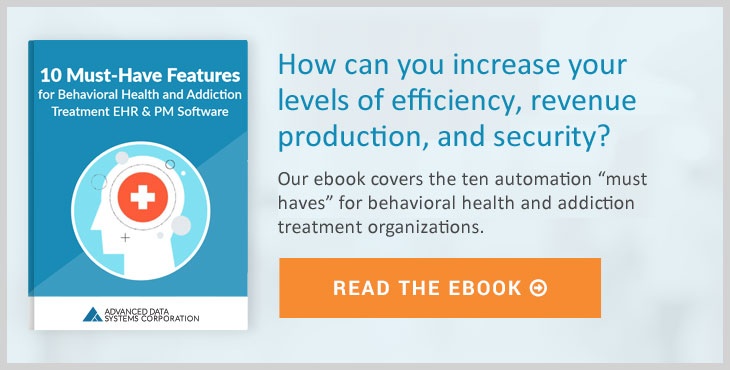The 6 Step Guide for Improving Your Person-Centered Care Feedback Strategy
Substance use treatment has changed. No longer do programs adhere to a single pathway for treatment. In 2019, you must treat each person individually because what works for one person doesn’t always work for another. Multiple pathways for recovery create more options to aid in the recovery process. It’s pertinent to know you’re living up to your responsibility in providing care that is person-centered, holistic, and stress-free.
Here are 6 steps for improving your feedback strategy to ensure your substance use treatment facility is providing person-centered care.
1. Dedicate time to discuss the current treatment experience
To ensure your patients are being treated as individuals, speak with each individually about their treatment.
During individual sessions, clinicians need to make time to ask each person how they feel their treatment plan is going, the quality of care they’re receiving, and what they like or dislike about the treatment facility. Obtaining feedback is essential to understanding what is working and what isn’t in your substance use treatment program.
2. Collect feedback about your treatment facility
In a 2019 NCBI study, psychologist Heidi Brattland studied the effectiveness of creating therapeutic relationships, finding that treatment facilities that adopted a system to regularly collect feedback from their addiction recovery patients were 2.5 times more likely to invoke lasting change. The study proved that regularly using a feedback-informed treatment system to rate the quality of the clinician/staff/person relationship improved overall performance and treatment outcomes compared to when ratings weren’t provided.
3. Implement a Feedback Informed Treatment System
The Outcome Rating Scale (ORS) and Sessions Rating Scale (SRS) comprises a simple four question survey designed to assess the magnitude and effectiveness of your therapeutic relationships with your patients.
According to Scott Miller, the developer of the SRS rating scale, the SRS is administered, evaluated, and discussed at the end of each session to get real-time feedback from patients to determine whether your substance abuse treatment program is creating an environment which fosters change.
Collecting feedback about all departments in your facility ensures patient satisfaction and improves treatment outcomes. Therefore, it’s essential to collect data in other areas to improve the overall performance and provide the highest quality of person-centered care.
It’s critical to understand how the person feels about the billing process, the overall performance of the facility, how well the administrative team resolves issues, and how well the facility communicates with other health providers, legal resources, and referral agencies.
Adopting a system into practice to collect data from your patients will increase the quality of care, improve person-centered pathways for recovery, and allow for changes to be made based on outcomes found within the data.
4. Utilize surveys to collect treatment feedback data
There are several ways your clinicians can collect data from those in treatment.
At the end of individual sessions, a short survey can be administered to collect feedback. It’s vital to inform the person that these questions will improve the quality of care provided, and to please answer openly and honestly.
When clinicians are asking the questions during a session, they must refrain from discussing or disputing the feedback. People must feel comfortable enough to openly discuss their feelings about the quality of person-centered care.
One way to remove any trepidation in rating the performance of a clinician face-to-face is by using a brief survey to be filled out by the person at the end of each session, once per week or month. The study can rate individual sessions, group sessions, and overall performance of the facility and its staff.
Another way to collect data is by creating a reception or self-registration kiosk using an iPad to collect data. Electronic data collection creates a user-friendly experience for patients and facility staff. Using Google forms, for example, in conjunction with iPads creates a friendly user experience while collecting data; they’re ideal for administering surveys and gathering data while helping to keep it organized. Its form builder also scores the data collected. People can complete surveys while waiting to attend individual therapy or group sessions.
HIPAA Compliance
It’s crucial to follow several steps before using any cloud-based application to collect data.
“Before any cloud-based service can be used by HIPAA covered entities or their business associates in connection with PHI, it is first necessary to enter into a business associate agreement (BAA) with the service provider. Without a BAA in place, the use of the service would be considered a HIPAA violation.” (Learn more about Google forms and HIPAA Compliance here.)
Going back to weekly and monthly surveys: in addition to weekly treatment rating surveys, monthly surveys should be conducted to collect data on the overall performance of the program. It’s crucial for the reception department (or whomever is appropriate at your facility) to administer monthly surveys about the facility’s overall performance, communication, and health record sharing between various healthcare providers, billing, administrative, reception, and any other applicable departments.
5. Review feedback and identify opportunities
As stated several times, understanding how your patients feel about their treatment process is crucial to providing quality care. In substance use treatment, readiness for change can become an issue especially when attempting to resolve issues between those in treatment and clinicians.
Once you’ve successfully adopted a system to collect data rating your facility and quality of care, a facility director can better understand the person’s feelings about both.
Not only can this data guide you in adjusting person-centered treatment, but you can use it to understand the person’s readiness for change, compliance with treatment policy, and determine if a dispute is the result of the person simply having a bad day, or if the situation has been building for some time.
Many times, assumptions relating to denial - or the readiness to change - create tension between a clinician and the person. Performing routine surveys will help facility directors understand (1) how to approach conflicts, (2) where the person is in their openness and willingness to change, and (3) how to best create an environment conducive for change.
6. Use the data collected to make appropriate changes
Once the feedback received is organized, clinical program directors should see trends in quality of care, the facility’s overall performance and more granularly, group therapy sessions and the individual therapy provided.
Clinical directors must use this feedback to make the appropriate changes needed to improve the performance of the substance use treatment program. Unlike overseeing a group therapy session, directors typically don’t get to see how clinicians work individually with clients.
EHR notes reflect the treatment plan’s objectives and the outcomes of individual sessions which is especially helpful since again, clinical directors rarely see how individual treatment sessions are going. Asking the right questions to receive feedback allows a director to help improve the overall quality of his or her team.
Using surveys can help a director better understand what the clinician is doing to create readiness for change, how well they’re connecting with the client, and where therapeutic processes need improvement, if any.
Improve your treatment outcomes
As has already been stated numerous times, the best way to understand therapeutic relationships between both parties is to use surveys, especially since people in treatment and providers don’t always agree about the quality of person-centered care provided.
Survey Monkey conducted a study and found that 8 in 10 healthcare providers believed their treatment sessions were beginning on time, but only 52% of patients surveyed believed this statement to be true. The point is you don’t know how your people in treatment feel about the quality of the care you provide unless you ask.
Adopt into practice a quick and easy way to collect information about the quality of person-centered care your treatment program provides by using a feedback informed system such as an SRS or ORS.
Ultimately, obtaining the data isn’t enough; you must use it to make the appropriate changes to ensure your patients receive the highest quality of person-centered care possible.
About John Makohen
John Makohen is a freelance writer who helps Drug Rehabs and B2B SaaS companies with their content needs. He also holds a CASAC and CRCP. He has helped numerous addiction recovery services, such as The Lighthouse Sober Living, The PAC Program of New York, and Serenity Parks Recovery with the SEO and website content. His work has also been seen on Blogging Wizard, Make a Living Writing, and The Addiction Blog. When he isn't working he enjoys long runs, dark coffee, and coaching clients to drug-free highs.



